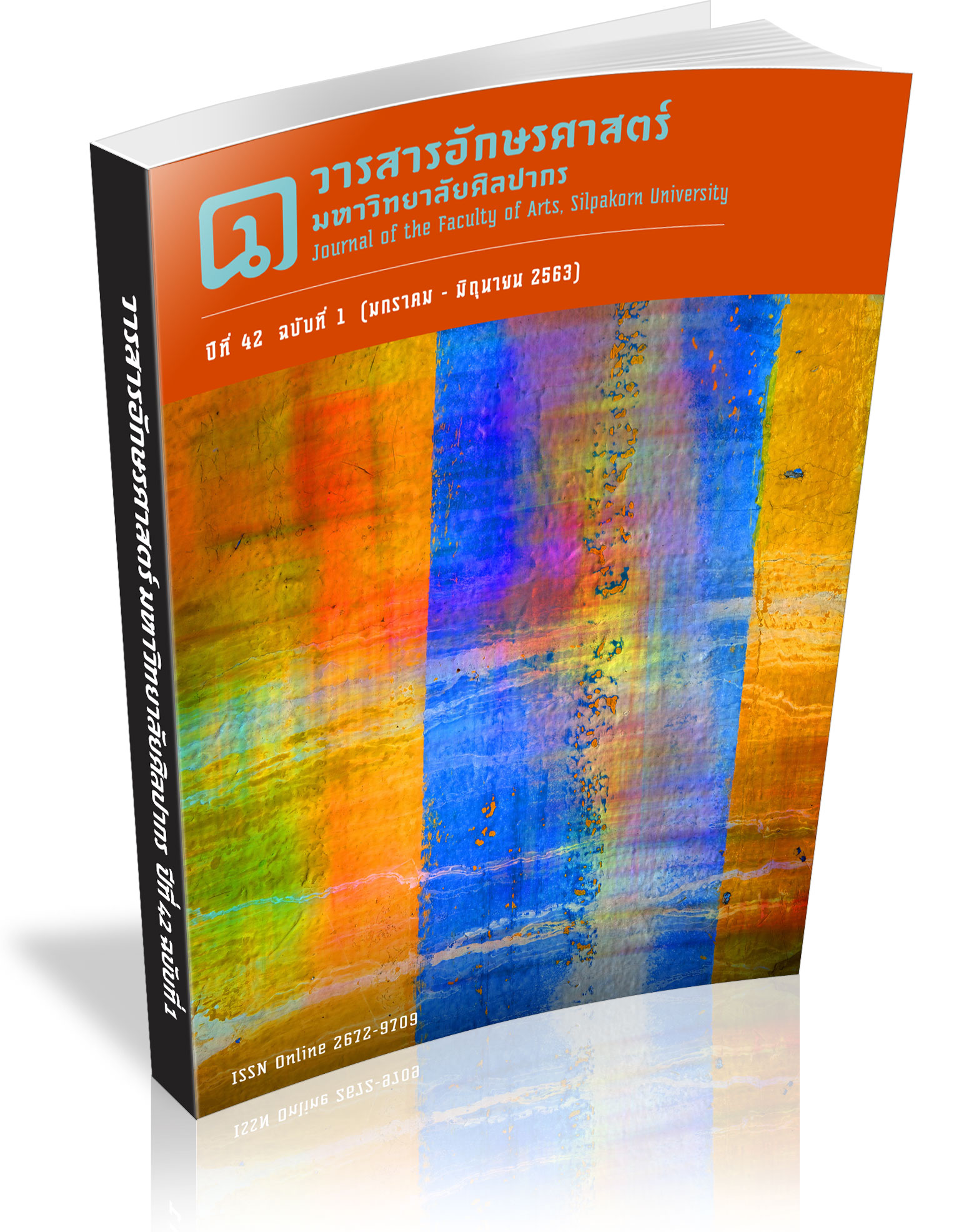ภาพตัวแทนของวัฒนธรรมไทยผ่านการทำอาหารไทยในฝรั่งเศส: กรณีศึกษาของสถาบันสอนทำอาหาร Atelier Thai
คำสำคัญ:
สัญวิทยา, สัญศาสตร์, ภาพตัวแทน, อาหารไทย, ภาษาฝรั่งเศสบทคัดย่อ
งานวิจัยนี้มุ่งศึกษาการใช้สัญญะเพื่อนำเสนอภาพตัวแทนของวัฒนธรรมไทยในฝรั่งเศส โดยสถาบันสอนทำอาหาร Atelier Thai ที่เชี่ยวชาญในการสอนทำอาหารไทยในประเทศฝรั่งเศส ผู้วิจัยใช้แนวทางการวิเคราะห์แบบ Constructionist Approach ของสจ๊วต ฮอลล์ และแนวทางการวิเคราะห์สัญญะของโรล็องด์ บาร์ตส์ โดยเก็บข้อมูลจากภาษาที่ใช้ในสื่อประชาสัมพันธ์ ได้แก่ เว็บไซต์ และหน้าเพจเฟซบุ๊กขององค์กร ผลการวิจัยแสดงให้เห็นภาพของอาหารไทยที่มีเอกลักษณ์ มีความประณีต อร่อย และมีรสชาติที่หลากหลาย การทำอาหารไทยจัดเป็นการแสดงออกทางวัฒนธรรมในฐานะที่เป็นประเพณีและนำเสนอผ่านเรื่องเล่า นอกจากนี้ ความแปลกใหม่และความรื่นรมย์จากอาหารไทยยังช่วยเปิดโลกทัศน์ เป็นการค้นพบสิ่งใหม่ มีการใช้อุปลักษณ์ “อาหารไทยคือการเดินทาง” เพื่อบ่งบอกว่าสิ่งนี้ชักนำให้ผู้เรียนชาวต่างชาติได้รู้จักกับวัฒนธรรมไทย จากการศึกษายังพบด้วยว่าการเรียนทำอาหารไทยเปิดโอกาสให้ผู้เรียนได้เป็นผู้สร้างสรรค์ผลผลิตทางวัฒนธรรมด้วยตนเอง การสอนทำอาหารไทยจึงเป็นเครื่องมือที่มีประสิทธิภาพในการถ่ายทอดอัตลักษณ์ของวัฒนธรรมไทยให้เป็นที่รู้จักในประเทศฝรั่งเศส
Downloads
เอกสารอ้างอิง
Art and Culture. (2019). Thai food is spicy but chilies didn’t belong to Thai. Since when have we eaten chilies?. Retrieved April 13, 2020 from https://www.silpa-mag.com/history/article_32860 (In Thai)
Atelier Thai. (2019). Atelier Thai by Ban Sa Bua. Retrieved October 10, 2019 from http://www.atelierthai.com
Atelier Thai. (2019). Atelier Thai. Retrieved October 10, 2019 from https://www.facebook.com/Atelierthai
Barthes, R. (1970). Mythologies. Paris: Seuil.
Barthes, R. (1985). L’aventure sémiologique. Paris: Seuil.
Berger, A. A. (1995). Cultural criticism: a primer of key concepts. Thousand Oaks, Calif: SAGE Publications.
Department of International Economic Affairs, Ministry of Foreign Affairs. (2017). Department of International Trade Promotion enhances the competitiveness of Thai restaurants overseas. Retrieved December 10, 2019 from http://www.mfa.go.th/business/th/news/ (In Thai)
Eco, U. (1988). Le signe. (J.-M. Klinkenberg, Trans.). Paris: Éditions Labor. (Original work published 1980)
Galland, X. (1998). Histoire de la Thaïlande. Collection « Que sais-je? », Paris: PUF.
Greimas, A. J. & Courtés, J. (1993). Sémiotique. Dictionnaire raisonné de la théorie du langage. Paris: Hachette.
Hall, S. (2013). The work of representation. In Hall, S., Evans, J. and Nixon, S. (Eds.), Representation, pp. 1-47, London: SAGE Publications.
Institut Français. (2006). Festival “Tout à Fait Thai”. Retrieved December 10, 2019 from https://www.pro.institutfrancais.com/fr/offre/festival-tout-a-fait-thai
Le Monde. (2010). Le "repas gastronomique des Français" inscrit au patrimoine de l'humanité. Retrieved December 10, 2019 from https://www.lemonde.fr/vous/article/2010/11/16/le-repas-gastronomique-des-francais-inscrit-au-patrimoine-de-l-humanite_1440921_3238.html
Macdonald, P. & Parkes, C. (2006). Thaïlande : les guides de voyage (I. Delaye & F.Fauchet, Trans.). Paris: la National Geographic Sociey. (Original work published 2001).
Montanari, M. (2006). Food is culture. New York: Columbia University Press.
Peirce, C. S. (1978). Écrits sur le signe. (Gérard Deledalle, Trans.). Paris: Seuil.
Rey-Debove, J. & Rey, A. (Eds). (2017) Le Petit Robert 2017. Paris: Le Robert.
ดาวน์โหลด
เผยแพร่แล้ว
รูปแบบการอ้างอิง
ฉบับ
ประเภทบทความ
สัญญาอนุญาต
ผู้เขียนบทความต้องยินยอมในข้อกำหนดต่าง ๆ ของวารสารก่อนส่งบทความตีพิมพ์




